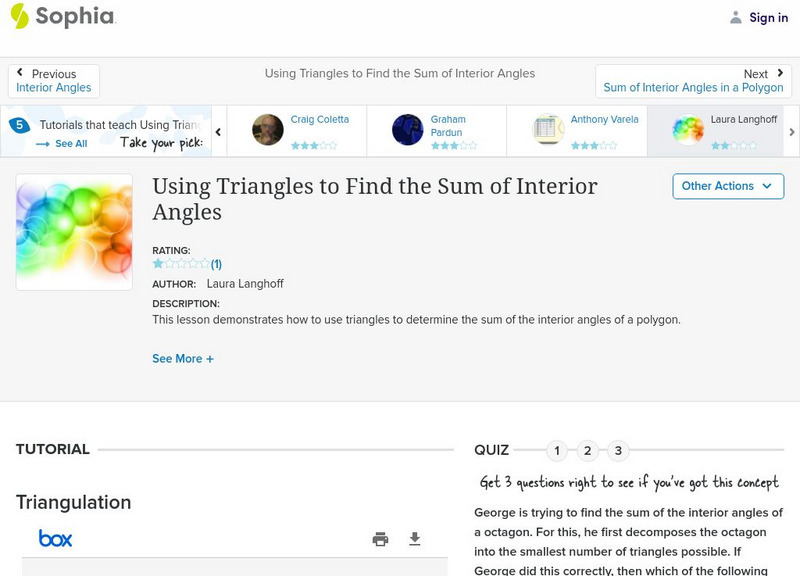Hi, what do you want to do?
Curated OER
Quilt Patch Proof
Students construct a convincing argument that the same amount of fabric is needed for each color of quilt being made in a specific design. They justify the relationship between vertical angles and the sum of the interior angles. Students
Curated OER
Triangle Conjectures
Tenth graders investigate the theorems of ASA, AAS, AAA and ASA. For this geometry lesson, 10th graders discuss the theorems of triangles and how it is used to solve for missing sides or angles. They review how two angles are formed by...
Curated OER
Geometry Worksheet #13
In this geometry worksheet #13 worksheet, 10th graders work in groups to solve 6 geometry problems, involving measurement of angles.
Curated OER
Algebra/Geometry Institute: Area of Polygons
Students find the area of polygons. In this area of polygons lesson, students find the area of parallelograms, rectangles, squares, and other polygons. They identify each given figure and determine the appropriate formula...
Curated OER
CSI Investigation of Congruence and Similarity
High schoolers differentiate between similarity and congruence using polygons. In this geometry lesson, students label triangles based on their properties. They find missing sides and angles using the interior sum theorem.
Curated OER
Polygons and Diagonals
Pupils practice measuring the interior angles of given regular polygons and create a formula for finding the measure of th interior angles of any polygon. They determine the relationships between the number of vertices's or sides in a...
EngageNY
Similar Triangles in Circle-Secant (or Circle-Secant-Tangent) Diagrams
First angle measures, now segment lengths. High schoolers first measure segments formed by secants that intersect interior to a circle, secants that intersect exterior to a circle, and a secant and a tangent that intersect exterior to a...
Curated OER
Polygons Multiple Choice
In this geometry worksheet, students identify the interior and exterior angles using the angle sum theorem. They identify and solve quadrilaterals using properties of quadrilaterals. There are 12 questions with an answer key.
Curated OER
Application of Delta-Epsilon Definition of the Limit
Students investigate the concept of a Limit and how it is used in a variety of problematic situations. They fold paper to help illustrate how to form equilateral triangles and explain how all the angles are the same. The activity...
Curated OER
Pythagorean Theorem
Students investigate the concept of the Pythagorean Theorem. After conducting independent practice to find the hypotenuse of a triangle, they work with the teacher using examples in the lesson plan. The direct instruction is delivered...
Curated OER
Triangle Inequality Theorem
Students use the inequality theorem to solve triangles and their properties. In this geometry lesson, students are given spaghetti of different lengths and asked to create triangles. They conclude the necessary length needed to make a...
Curated OER
Perimeter
In this perimeter worksheet, 10th graders solve and complete nineteen various geometry problems. First, they find the length of given segments in addition to the perimeter of a kite. Then, students find the value of a variable so that...
Curated OER
Polygons All Around Us!
Students explore the concept of polygon properties. In this polygon properties lesson, students draw polygons with different numbers of sides such as pentagons, octagons, hexagons, etc. Students identify different geometric shapes in the...
Curated OER
Designing a Quilt Pattern
Students create and color a one-patch quilt design based upon a regular hexagon. They examine quilts and photos of quilt designs, read a handout, and complete their quilt design on a worksheet.
Curated OER
More on Tessellations
In this tessellations worksheet, 10th graders solve 3 different word problems that include creating various tessellations. First, they group pentagons around a vertex so the angles add up to 360 and determine whether the pentagons can...
Curated OER
Hidden Jewels of Geometry
Students identify different geometric shapes, and arrange them artistically in original jewelry designs.
Curated OER
Strongest Polygon
Students define and identify shapes by name. In this geometry lesson, students construct, identify and compare polygons based on the number of sides. They classify each shape based on their angle sum theorem.
Curated OER
Solidly Platonic
When they do, they learn. Using this resource, young mathematicians learn about platonic solids by actually building, touching, and examining the shapes. They connect their observations about the shapes to Euler's formula.
Willow Tree
The Pythagorean Theorem
There isn't a more popular geometry formula than the Pythagorean Theorem! Learners understand the special side relationships in a right triangle. They use the Pythagorean Theorem to find missing sides and to solve problems. They begin...
Curated OER
Pattern Block Polygons
Sixth graders create polygons. In this shapes lesson, 6th graders explore prefixes such as oct, tri, quad, pent, etc. and share their findings. Students use pattern blocks to create two different polygons and label them.
Curated OER
Structures and Shapes
Students make jewelry using different shapes from magazines, tissue paper, cardboard, and other materials. In this making jewelry lesson plan, students complete this hands on activity to discuss how shapes are used.
Texas Instruments
Texas Instruments: Sum of Interior Angles in a Triangle With Cabri Jr.
Students will discover the sum of the interior angles in a triangle using the Cabri Jr. Application.
Texas Instruments
Texas Instruments: Extension: Parallel Lines and the Sum of the Angles
Students construct a line parallel to the base of a triangle and measure the angles formed. They use the construction to prove that the sum of the measures of the interior angles of a triangle is 180 degrees.
Sophia Learning
Sophia: Using Triangles to Find the Sum of Interior Angles: Lesson 1
This lesson demonstrates how to use triangles to determine the sum of the interior angles of a polygon. It is 1 of 5 in the series titled "Using Triangles to Find the Sum of Interior Angles."




























